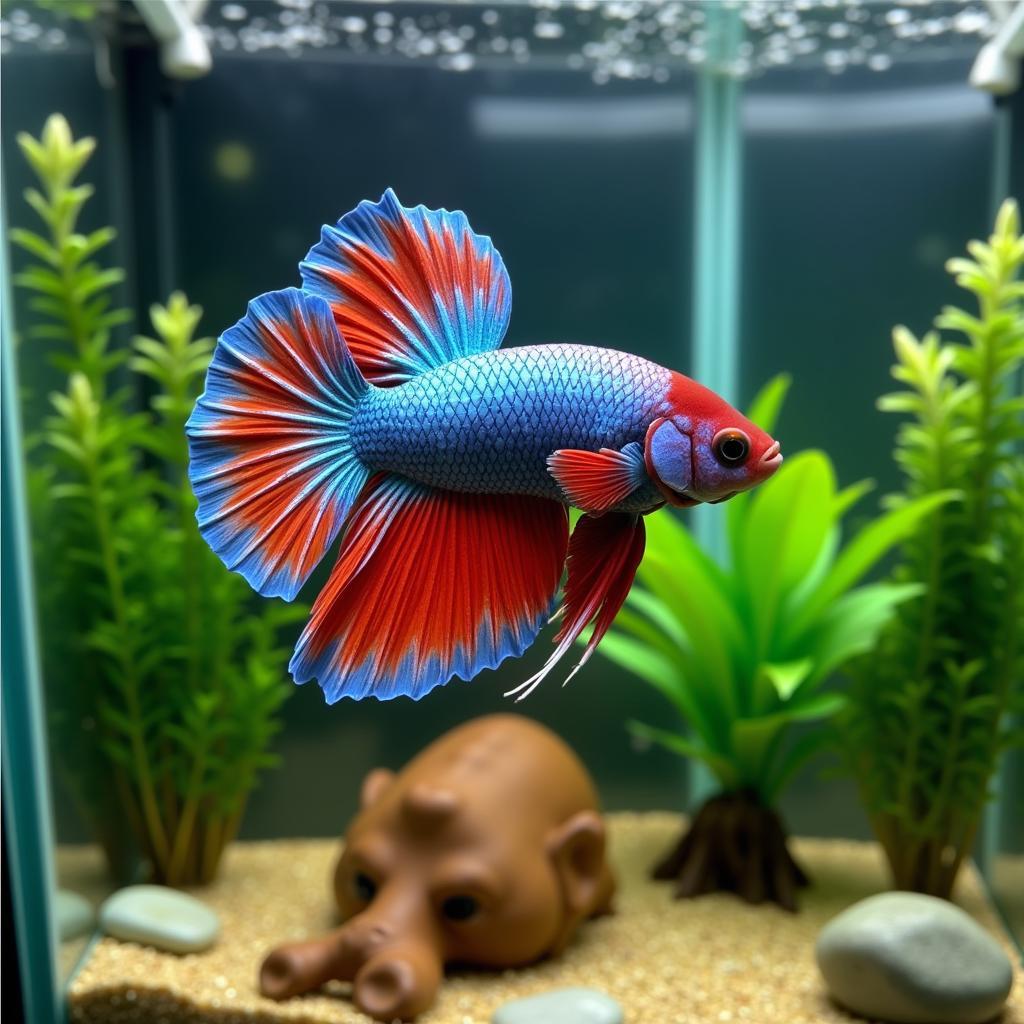If your vibrant betta fish is starting to look a little washed out, you’re likely wondering, “Why Is My Betta Losing Color?” Color loss in bettas, also known as fading, can be alarming, but it’s often a symptom of an underlying issue rather than a disease itself. Let’s explore the common reasons behind this phenomenon and how to restore your betta’s brilliant hues.
Understanding Betta Color Changes
Betta fish are renowned for their stunning array of colors, from fiery reds and oranges to deep blues and purples. These colors are produced by pigment cells called chromatophores in their skin. Changes in these cells, influenced by various factors, can result in color loss or gain. Sometimes, the change is natural, while other times, it indicates a problem with their environment or health.
Stress: A Major Culprit
One of the most common reasons for betta color loss is stress. Just like humans, bettas experience stress, and it manifests in various ways, including fading color. Stressors can include a poor water quality, an unsuitable tank environment, aggressive tank mates, or even sudden changes in temperature or lighting.
Water Quality Issues
Poor water quality is a significant stressor and a primary reason for color loss. Ammonia, nitrites, and nitrates are toxic to bettas and can cause a range of health problems, including fading. Regular water changes and proper filtration are crucial to maintaining a healthy aquatic environment.
Disease and Illness
While color loss itself isn’t a disease, it can be a symptom of various illnesses. Bacterial, fungal, or parasitic infections can all contribute to fading. If your betta is losing color and exhibiting other symptoms like lethargy, loss of appetite, or fin rot, consult a veterinarian specializing in aquatic animals.
Aging: A Natural Process
As bettas age, their colors naturally fade. This is a normal part of the aging process and is generally not a cause for concern. Just like humans get gray hair, bettas can experience a gradual dulling of their vibrant hues as they get older.
How to Restore Your Betta’s Color
Addressing the underlying cause of color loss is key to restoring your betta’s vibrancy. Here are some steps you can take:
-
Test Your Water: Use a reliable aquarium test kit to check for ammonia, nitrites, and nitrates. Ensure these levels are within the safe range for bettas.
-
Perform Regular Water Changes: Partial water changes of 25-50% every week or two will help maintain optimal water quality and remove harmful toxins.
-
Optimize Tank Conditions: Provide a suitable environment with appropriate temperature, lighting, and decorations. Ensure the tank is large enough for your betta (minimum 5 gallons).
 Vibrant betta fish in a clean, well-maintained tank
Vibrant betta fish in a clean, well-maintained tank
-
Provide a Nutritious Diet: Feed your betta a high-quality diet specifically formulated for bettas. A varied diet rich in protein and essential nutrients can help boost their immune system and enhance their color.
-
Reduce Stress: Minimize potential stressors like aggressive tank mates or sudden changes in their environment. Creating a calm and stable environment will help your betta thrive.
Why is My Betta’s Color Changing to Black?
Sometimes, a betta’s color change might be more specific, such as darkening or turning black. This can be due to several reasons, including stress, aging, or a genetic predisposition called melanism. Consult a veterinarian if you’re concerned about this specific color change.
Can Betta Fish Regain Their Lost Color?
Yes, in many cases, bettas can regain their lost color if the underlying cause is addressed promptly and effectively. Improving water quality, providing a healthy diet, and reducing stress can often lead to a noticeable improvement in their coloration.
“Addressing water quality is paramount. Often, a simple water change can make a world of difference in a betta’s color and overall well-being,” says Dr. Emily Carter, a renowned aquatic veterinarian. “Providing a stress-free environment also plays a vital role in maintaining their vibrant hues,” adds Dr. Carter.
Conclusion
Understanding why your betta is losing color is essential for taking appropriate action. By addressing potential stressors and ensuring a healthy environment, you can help your betta regain its vibrant colors and thrive. Remember, regular monitoring and proactive care are key to keeping your betta happy and healthy.
FAQ
- How often should I change my betta’s water? Generally, 25-50% water changes every 1-2 weeks are recommended.
- What is the ideal tank size for a betta? A minimum of 5 gallons is recommended for a single betta.
- Can I keep two bettas together? Male bettas are typically aggressive towards each other and should be kept separately. Females can sometimes be kept together in a sorority tank, but careful monitoring is essential.
- What should I feed my betta? High-quality betta pellets or flakes, supplemented with occasional live or frozen foods like bloodworms or brine shrimp.
- How can I tell if my betta is stressed? Signs of stress include color loss, lethargy, loss of appetite, fin clamping, and hiding.
- What should I do if my betta’s color doesn’t improve? Consult a veterinarian specializing in aquatic animals for diagnosis and treatment.
- Is it normal for a betta’s color to change slightly over time? Yes, slight color changes can occur due to aging or environmental factors and are not always a cause for concern.
Need more help with your Betta? Check out our other articles:
- Betta Fish Care Guide for Beginners
- Common Betta Fish Diseases and Treatments
- Setting Up the Perfect Betta Tank
When you need support, please contact us: Phone Number: 0373298888, Email: [email protected] Or visit us at: 86 Cầu Giấy, Hà Nội. We have a 24/7 customer service team.